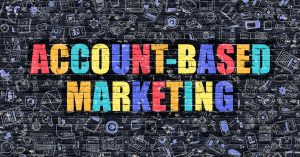Account-Based Marketing is a marketing strategy that focuses on specific accounts instead of a big, broad market:
So what is account-based marketing, and why should you consider adopting it as a marketing strategy to grow your business? Account-based marketing, or “ABM” as us marketers call it for short, is a strategic approach to marketing in which the marketing and sales team promotes and seeks to sell to specific companies or accounts. It differs from traditional marketing in that instead of using a broad targeting strategy, ABM is all about targeting a few specific accounts that are most likely to convert into customers. Additionally, account-based marketing is more about quality than quantity. It’s not about getting your message out to as many people as possible. It’s about who you’re getting your message out to. David Ogilvy who was an advertising executive that was widely regarded as “The Father of Advertising” said: “Don’t count the people you reach; reach the people that count.” This quote essentially sums up what ABM is all about: It’s about reaching the right people, and delivering a message tailored especially for them.
In ABM, marketers take an individual prospect or customer account and treats it like its very own market. It’s marketing that’s based around a specific account and its specific characteristics and needs. It’s most relevant in the business to business, “B2B,” world. It’s most useful when you’re trying to acquire specific high-value customers. You will find that ABM works better than taking a wide-ranging approach to sales and marketing efforts.
The traditional marketing process focuses on what you, the marketer, wants to say, then on which communication platform to say it, and lastly to who to say it. However, ABM focuses first on to who to say it, then what to say, and lastly on which communication platform to say it. Having the order switched around allows the marketers that use an ABM strategy deliver a message that is all about their audience. It enables the communication to be personalized, relevant, and helpful to your audience.
It’s more personalized:
People can tell when you send a blast email to thousands and thousands of recipients, and a lot of times that alone can be a turn off for people. People don’t want to just be thrown into a large batch email list, and emailed on a massive scale just because it was convenient for you as the marketer or salesperson. Your recipient is much more likely to read your email when that person knows that your email was meant specifically for him or her, or when they were expecting to receive it. Your recipient wants to feel like you’re tending to their needs as if you are working solely for him or her. So what does that mean– just use some sort of email automation to have the email automatically include their first name in the subject line, or in the body of the email? Absolutely…not. It’s much more than that. It has to be much more personalized. You have to speak their industry lingo and use the same terminology that they use. You have to speak their language.
It’s more relevant to your target audience:
Sure including that person’s name adds a more personal touch to your email, but people are well aware that their name in that email was probably automatically generated by a robot. As marketers and sales people seeming like a robot can be a turn-off, so please, turn-off the robotic sales and marketing approach. Instead add way more than just your recipient’s name. You need to make your email not only personalized, but relevant to your reader. So how do you know what will be relevant to your reader? You have to do some digging: Do some research and identify the pain-points and challenges within your targets’ industry for example, and tailor your message around that. Your audience will appreciate that, and will likely be more open to opening your emails in the future if they know that your emails aren’t “salesy,” but actually relevant, and helpful to them. You need to nurture your leads until they are ready to buy. ABM is great when you’re trying to go after an organization that has multiple stakeholders involved in the deal, because having so many so many stakeholders in a given sale would otherwise be difficult and inefficient if the ABM approach wasn’t being used.
Check back in for part 2.




